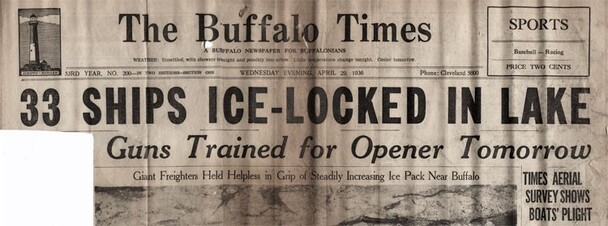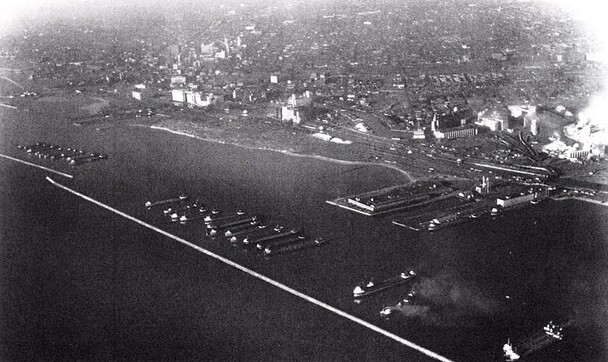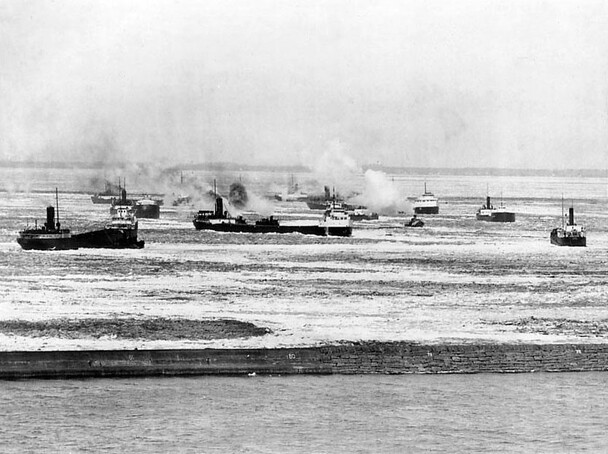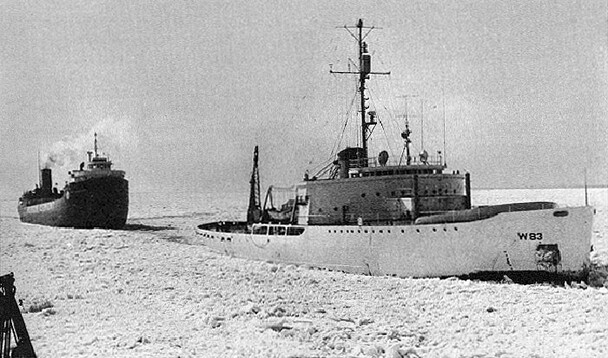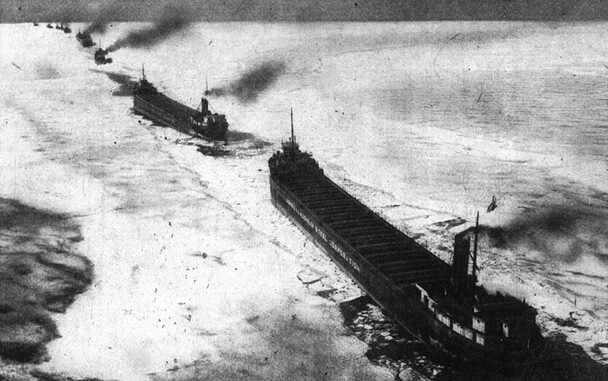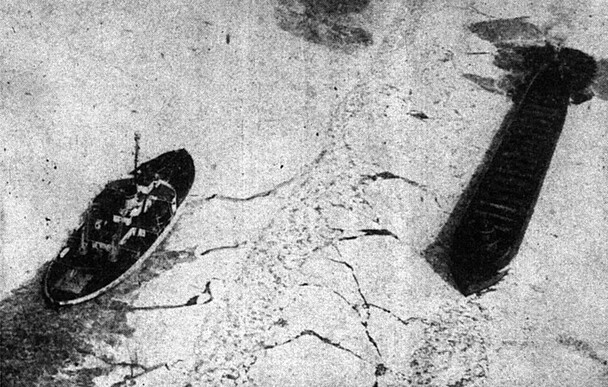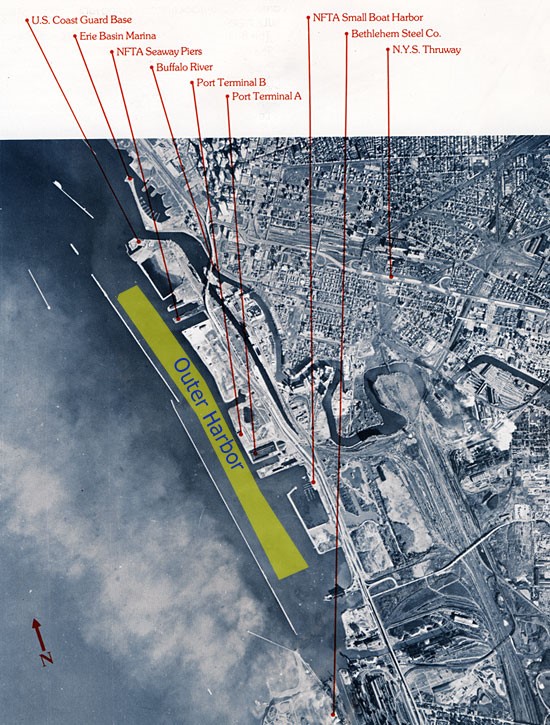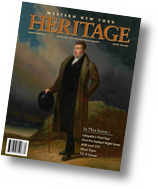Industry in the Buffalo region operated according to the cycle of the seasons from the beginning of commercial traffic on the Great Lakes in the early 1800's. During the winter, which on the lakes began at the end of December or early January, lake freighters could not navigate the frozen lakes to bring iron ore or grain to Buffalo's factories. This meant a lack of work for grain scoopers and dock workers. Spring meant that these workers would again bring home a paycheck. Everyone involved, including company owners and investors, looked forward each year to the date when the lakes were open again to navigation.
Author Harlan Hatcher said this in his 1945 book, Lake Erie:
"There is always an electric wave of excitement in the ports when the word comes that the icebreakers have cleared a channel through the St. Marys River and Whitefish Bay, and the first ships head out from their winter berths for the ore docks at Duluth. A dozen of them leave port the on first day, and about the same number are placed in commission on each succeeding day until the entire fleet is under way. The stock piles which they had heaped mountain-high at Buffalo, Conneaut, Ashtabula, Cleveland and Toledo during the preceding season have dwindled low as the endless railroad cars have been loaded with ore and hauled off to the furnaces all winter long. Now the giant freighters, which have lain dormant in the ice for four months, come to life again and seem to share in the general excitement as they wallow through the spring seas and crunch the blocks of floating ice that wash against their high-riding bows. They are off in their native element once more to fill up their empty red bellies with ore on Lake Superior and disgorge it on Lake Erie to rebuild the stockpiles."

Accompanying front page photo of ships outside Port Colborne, Ontario. Image source: private collection
The headline story in the April 29,1936 Buffalo Times described 600-foot "giants of the lake" trapped off Port Colburn, Ontario. After a thaw, a strong southwest wind had come up and created ice jams of packed ice that stalled the ships. They were unable to return to the clear harbor at Port Colborne, and also unable to find breaks in the ice.
The reporter said, "Great plumes of smoke billowed from the stacks of most of the boats and here and there a propeller could be discerned beating the water with apparently little effect. Other boats seemed to have given up on the struggle, awaiting a break in the ice. Few appeared to be making any actual progress."
Buffalo's Outer Harbor was created by the construction of nearly three miles of breakwater between 1898 and 1903. This allowed anchorage for ships waiting to unload and also became a winter lay up. There could be as many as 70 freighters moored for the winter in some years, many of which contained wheat to supply the elevators and grain mills until spring.
The caption for the above wire photo said, "Not very warm for May. Here it is the merry month of May, when all those flowers are supposed to be blooming after the April showers, and yet above photo shows a dozen freighters struggling in ice outside Buffalo harbor. Brrrr."
The Coast Guard Icebreaker Mackinaw, W83, was commissioned in 1944 and operated on all of the Great Lakes until 2006, when it was decommissioned. It was built during World War II with funds allocated by Congress specifically to keep the Great Lakes open as long as possible into the winter to supply the steel plants with ore for war work.
The Mackinaw could break 2 1/2 feet of ice continuously and 11 feet by backing and ramming. During the war, the period of time the Great Lakes were closed to navigation was reduced from 4 1/2 months to an average of 3 months thanks to "Big Mac," as the ship was affectionately called.
According to a Coast Guard record, "From 9 to 13 May 1947, aided by the CGC Tupelo, Mackinaw 'restored order' from the utter confusion in Buffalo Harbor which was ice-blocked, trapping dozens of vessels. The icebreakers freed 38 of the steamers and escorted them into the harbor and freed and escorted out another 49. The following year, from 17-18 March 1948, she repeated rescue efforts and opened a passage that freed 12 ice-locked ships at Buffalo, activities that she conducted nearly every spring in the coming years."
In 2014, the Mackinaw W83 was berthed in Mackinaw City, Michigan, open for public tours.
The original caption for the above image, when it appeared in the March 18, 1948 Courier-Express, read: "Follow the Leader. Seen from the air and resembling toy ships wallowing single-file in a basin of soapsuds, these 12 Great Lakes freighters yesterday left Buffalo harbor in the wake of the Coast Guard Icebreaker Mackinaw which escorted them through Lake Erie ice in the earliest opening of the port on record. Previous earliest start of shipping here was March 20, 1919."
(From TIME, March 29,1948)
At Buffalo one morning last week the Coast Guard's broad-beamed icebreaker Mackinaw began smashing its way across the icebound harbor. A helicopter rose from its deck and flew ahead to hunt crevices and soft spots, radio back the line of least resistance. In a few hours, the Mackinaw-helicopter team - the first used on the Great Lakes - had cleared a channel out into Lake Erie. A dozen ore carrier s snaked along the narrow channel and followed the icebreaker down to Cleveland, thus opening navigation on the lower Great Lakes.
For Buffalo, it was the earliest port opening on record, 52 days ahead of last year. Shippers hoped that this meant an early opening for the rest of the Great Lakes, usually ice-bound till mid-April. It would come none too soon for steelmen. Their stockpiles of ore were so low that some mills were planning the expensive makeshift of shipping by rail from Minnesota's Mesabi range...
The U.S. Coast Guard conducts two ice-breaking operations on the Great Lakes each winter. The new icebreaker Mackinaw WLBB-30 (commissioned in 2006) is the icebreaker assigned to do this job. It is the only Great Lakes Coast Guard vessel capable of breaking the thickest ice formations.
The St. Lawrence Seaway System announces when the spring shipping season begins, but Nature decides when the Great Lakes are navigable. In 2014, the Welland Canal opened March 28, but the first vessel through the locks had to wait in the Canal because Lake Erie ice was too thick.
The Mackinaw was on Lake Superior at that time, trying to clear a path for ore boats to resupply Gary, IN steel plants.
